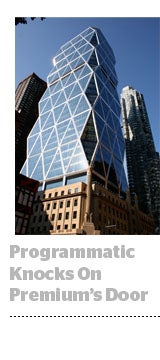 The walled gardens around publishers’ premium inventory are hard to take down, since publishers are reluctant to put premium inventory in channels associated with low-priced, performance-focused inventory.
The walled gardens around publishers’ premium inventory are hard to take down, since publishers are reluctant to put premium inventory in channels associated with low-priced, performance-focused inventory.
But Sonobi, whose platform combines direct-sold impressions with those sold programmatically, is trying to chip away at those walls. The company hosted a Premium Programmatic Summit with its partner MediaMath and its client Hearst on Tuesday.
“I think one of the fears publishers have is [that] the way display moved to programmatic was a disaster and a poor case study,” said LUMA Partners founder and CEO Terence Kawaja. “As we move to premium inventory and ad formats like video, native, TV – that’s where publishers are making their money, and they don’t want to mess up the ecosystem like we did with display.”
Sonobi believes that if publishers let all their inventory compete – both programmatic and premium – programmatic impressions may outbid direct-sold ones. The way many publishers have waterfalls set up now, a $7 direct-sold CPM will win against a $10 CPM received programmatically. But if the bids and direct-sold inventory arrive at the same time, the highest price wins. This benefits both publishers and advertisers: When advertisers know a publisher exposes all of its inventory, they feel better assured of campaign delivery.
For some publishers, bringing programmatic into premium environments made perfect sense. “The reason we have made all our inventory available programmatically is that if an advertiser is willing to buy at a rate that will compete or beat, there is no reason we shouldn’t take that,” said William Murray, VP of sales planning and strategy at Scripps.
Other publishers struggle to get higher CPMs in programmatic.
Gretchen Grant, president of home-improvement site BobVila.com, bemoaned the difference in CPMs between direct sold and programmatic. Telling the story of the site to advertisers, or selling on context, gets the site its premium CPMs. Audience-targeted impressions net the site fractions of its brand buys, not its audience.
Agencies acknowledged being part of this problem. “Business Insider has the same audience as The Wall Street Journal for 10% to 20% the price,” said Adam Heimlich, SVP of programmatic at Horizon. “The price is being degraded, but it’s such a better deal.”
However, proponents of programmatic say it makes the buying process easier, and the ability to inform buys with data drives value.
MediaMath CCO Mike Lamb lamented “the number of man-hours wasted on deals that deliver $100.”
Premium programmatic deals help reduce delivery problems, but they also cost more. “We’ve had to pay a huge premium to vault over that reserved inventory,” Lamb said of the agency’s foray into programmatic direct using Sonobi.
In its tests with the platform, MediaMath had to set up separate budgets from the open exchange. Because CPMs were three to four times higher in the premium programmatic environments, the learning engines would rarely choose a high-priced impression in a field with so much lower-priced inventory.
But the results encouraged Lamb. CPCs were roughly the same compared to open exchanges, but CPAs halved. “The buyers for whom these work the best are those that have deep business outcomes they want to drive, like multichannel retailers, [consumer packaged goods], financial services and auto,” Lamb said.
That’s in part because these deals generally bring in first-party publisher data, enabling more precise audience targeting. Those deals also tend to deliver in full. Sonobi’s platform overlays first-party data against site traffic, enabling precise forecasting of how many impressions can be delivered against high-value segments. That combination of data, scale and premium checks boxes for performance and brand advertisers alike.













